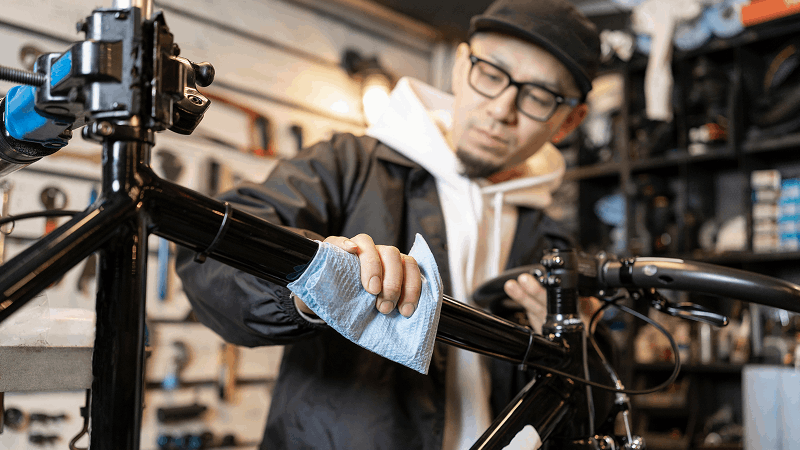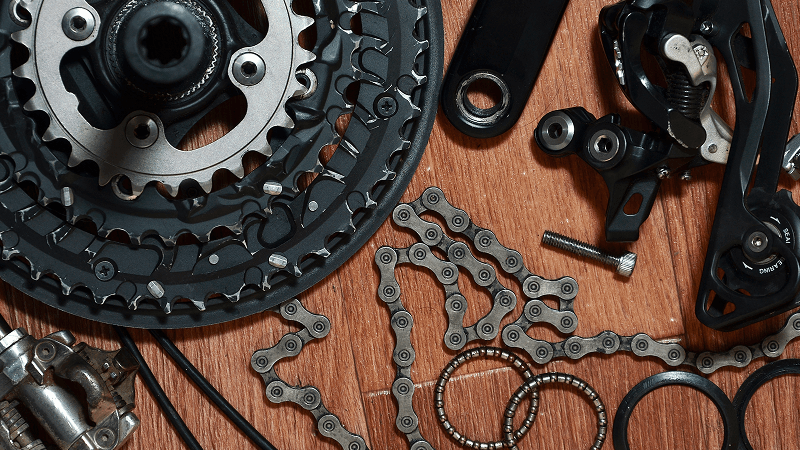Your bike is an investment. And like any valuable piece of equipment, it deserves better than being shoved in a hallway, left on a balcony, or hung from a rusty hook in a humid garage.
For those who don’t have a spacious garage or apartment space, a small self-storage unit can be the perfect bicycle storage solution. Not only will it be out of the way, but it’s also locked up tight and safe. However, good bike storage isn’t just about where you put it. It’s also how you prepare and position it that makes all the difference.
In this guide, we’ll break down everything you need to know about storing a bike in a self-storage unit so when it’s time to ride again, your bike is just as ready as you are.
Why Store a Bike in a Self-Storage Unit
Reliable self-storage providers offer clean, secure, and climate-controlled units for your bikes, which can sometimes be a smarter choice than keeping them at home. Here’s why:
-
Protect your bike from weather damage
Rain, sun exposure, and humidity are major enemies of metal and rubber components. Leaving your bike exposed to these conditions can lead to rust on the chain and frame deterioration of brake cables, and cracking of tires over time. Even covered outdoor storage doesn't offer complete protection from moisture and UV exposure.
On the other hand, storing a bike in small self-storage units, particularly climate-controlled ones, offers a dry, stable environment that significantly extends your bike’s lifespan
-
Free up valuable space at home
In many urban homes and apartments, bike storage can be a constant battle. Hallways, balconies, and living rooms aren’t designed for long-term storage, and hanging a bike on a wall isn’t always practical or renter-friendly. The best part is that a small storage unit, around 5x5 or 5x10, is enough to accommodate your bicycle.
Having a nearby self-storage unit helps free up square footage while keeping your bike safe and accessible.
-
Ideal for long-term or seasonal storage
If you're not riding year-round, such as during winter months or while recovering from injury, a storage unit allows you to safely store your bike away until you're ready to ride again. It's also useful during life transitions like moving, traveling, or when welcoming new housemates such as friends or family.

How to Prepare Your Bike for Storage
A bicycle is made up of finely tuned components that are highly sensitive to neglect. If you're planning on bike storage, you should give it the same care and attention as when you were actively using it.
Here’s how:
Step #1: Deep clean the entire bike
The first and most important step of pre-bike storage is a thorough bike cleaning. Any residue left on your bike, like mud, salt, or oil, can accelerate corrosion and wear, especially in a closed environment with no airflow.
Here’s what to clean:
- Start by rinsing off dirt and debris with warm water and a soft brush.
- Degrease the drivetrain (chain, cassette, derailleur) with a bike-specific degreaser. This removes oily buildup that can trap moisture or harden during storage.
- Clean the frame using mild soap and a soft sponge, paying attention to joints and welds where grime accumulates.
- Dry every surface completely with a microfiber cloth to ensure no water remains in crevices.
Step #2: Lubricate moving components after cleaning
Once the bike is dry, it's important to apply lubricant to protect key moving parts from seizing up. The important parts to pay attention to are:
- Chain: Apply a quality lubricant to the chain while slowly turning the pedals.
- Pivots, brake lever hinges, and other exposed joints: Use a small brush to make sure these small areas are lubricated.
Metal components without lubrication dry out and stiffen, which can affect shifting performance and increase wear on your first ride post-storage. However, make sure to wipe off excess lube to prevent it from collecting dust over time.
Step #3: Reduce tire pressure and elevate if possible
Let out about 30–40% of the air in each tire. Fully inflated tires resting in one position can develop flat spots or sidewall cracks, especially in unheated or concrete-floored units.
If possible, use a bike stand to keep the tires off the ground entirely. Alternatively, flip the bike upside down to rest it on the handlebars and saddle (place a mat underneath to prevent scratching).
Step #4: Remove electronics and accessories
Batteries degrade over time, and moisture buildup inside bags or bottles can cause mildew or odors. So, make sure to remove bike computers, lights, GPS units, and any battery-powered gear. Store batteries separately to avoid corrosion or leakage. Don’t forget to take off saddlebags, water bottles, tool kits, and inflators.
Organize these accessories into a clearly labeled box, so everything is easy to find later.
Step #5: Cover the bike but let it breathe
Cold floors can cause condensation and expose tires to temperature extremes, increasing the risk of cracking or warping. And while it’s tempting to cover up your bike in plastic, it can trap moisture, creating a greenhouse effect under the cover.
Use a breathable bike cover made of fabric or a cotton sheet instead to keep dust off while allowing air circulation. You can also lay a rubber mat, cardboard, or wood pallet under the bike to prevent contact with a cold concrete floor.

Here’s a complete checklist for your pre-bike storage preparations:
- Clean every part of your bike
- Wash the frame, wheels, and components with bike-specific soap.
- Degrease the drivetrain (chain, cassette, derailleurs).
- Dry the entire bike completely, including hard-to-reach areas.
- Lubricate moving parts
- Lube the chain, derailleur pivots, and brake levers.
- Wipe off excess lubricant to avoid dust accumulation.
- Avoid contact with brake pads or rotors.
- Reduce tire pressure and support the frame
- Reduce air pressure by 30–40% of your riding PSI.
- Use a bike stand or hang the bike to relieve tire stress.
- If resting on the ground, flip the bike and pad contact points.
- Remove accessories and electronics
- Remove GPS units, lights, and bike computers.
- Take out all batteries and store separately in a dry place.
- Detach bags, bottles, pumps, and tools.
- Store everything in a labeled container for easy access.
- Cover your bike the right way
- Use a breathable bike cover or cotton sheet, not plastic
- Avoid wrapping the bike in sealed materials that trap humidity.
- Lay a mat, cardboard, or pallet underneath the bike (never store directly on concrete).
- Final pre-storage check
- The bike is clean and completely dry
- Chain and components are lubricated.
- Tires are deflated slightly or fully supported.
- Accessories and batteries are stored separately.
- The bike is stable and not leaning against other objects.
- Unit is clean, dry, and temperature-consistent.

Best Bicycle Storage Ideas for Any Storage Unit Setup
Once your bike is prepped and ready, the next critical step is deciding how to physically store it inside your self-storage unit. Below, we explore the best bicycle storage ideas for self-storage units, including practical setups and space-saving bicycle storage solutions used by everyday cyclists, commuters, and serious hobbyists alike.
-
Freestanding bike racks: Simple, no-drill stability
Freestanding bike racks are one of the most practical and renter-friendly bike storage options, especially in small units and storage facilities that don’t permit wall mounting. These stands typically support one or two bikes upright by the frame or wheels and are quick to set up without tools.
The best part is that they allow bikes to remain fully assembled while standing independently. No need to lean them against boxes or walls (which can warp wheels or scratch paint). Models also vary in design. Some cradle the wheels, others support the top tube.
Best for:
- Short- to mid-term storage
- Anyone storing a bike alongside other household items
- Renters who can’t modify unit interiors
Pro tip: Choose a stable model with wide feet or rubber pads to prevent sliding on concrete floors.
- Floor stands & wheel chocks: Low-cost, no-fuss options ?
For casual riders or short-term storage, simple floor stands or wheel chocks are reliable and affordable. These devices hold your bike upright by stabilising one wheel in a cradle, making them perfect for quick access and re-entry.
This option keeps bikes from tipping over or leaning, which can damage derailleurs or handlebars over time. And while not the most space-efficient, they offer basic vertical support with minimal setup
Best for:
- Temporary storage
- Budget-conscious cyclists
- Commuter or utility bikes
- Ceiling hoists & pulley systems: Save floor space by going up
In units with higher ceilings and where facility rules allow, ceiling hoists can be a game-changer. These systems use pulleys and hooks to lift your bike off the ground and secure it near the ceiling, freeing up the floor entirely.
This approach eliminates any pressure on tires, prevents warping, and creates space below for boxes or other equipment. It's especially effective for long-term storage where frequent access isn't needed.
Best for:
- Storing multiple bikes
- Maximizing vertical space in small units
- Long-term storage with little need for frequent access
Always check with the storage facility before installing ceiling hardware. Not all units permit drilling or overhead mounting.
- Vertical Wall Mounts & Hooks: Compact & Organized
Vertical wall-mounted storage where the bike hangs from its front wheel or top tube is a popular solution for garages and home storage, and can be used in storage units if allowed. By hanging your bike vertically, you instantly reclaim floor space.
This method also keeps the drivetrain and components free from accidental contact with other stored items.
Best for:
- Mid- to long-term storage
- Facilities where light modifications are allowed
- Riders storing multiple bikes vertically along a wall
Pro tip: Always anchor mounts into a wall stud, and use padded hooks to avoid damaging rims or paint.
- Bike storage bags & boxes: Full protection for high-value bikes
If you're storing a high-end road bike, carbon frame, or e-bike, it may be worth placing it inside a padded bike bag or hard bike box.
A properly packed bike bag protects components and finish from scratches, while also reducing exposure to airborne dust or temperature swings. Meanwhile, hard cases are ideal if you're storing a disassembled bike or planning to travel with it later
No matter your choice, always ensure the cover is breathable. Avoid fully sealed plastic wraps, which can trap condensation and lead to rust.
Best for:
- Premium or collectible bikes
- Climate-variable units (non-temperature controlled)
- Situations where dust or contact risk is high
- DIY bike cradles using furniture or boxes
If you're trying to make the most of your small storage unit without buying additional racks, you can improvise using items you already have, like sturdy shelves, storage bins, or even padded furniture. These DIY cradles can support your bike upright or sideways with minimal contact to sensitive parts
Just make sure the surfaces are stable and won’t shift over time.
Pro tip: Pad any contact points with towels, foam, or cardboard to prevent scratching the frame or misaligning components like the derailleur.
Best for:
- Budget-conscious storage setups
- Units already filled with boxes or shelving Climate-variable units (non-temperature controlled)
- Short- to mid-term storage
Store Your Bike the Smart Way with Stuf Storage
From prepping your bike for long-term storage to managing climate challenges and security risks, the right approach ensures your ride stays rust-free, functional, and ready to roll.
At Stuf Storage, we make it easier. With thoughtfully located, app-enabled self storage spaces across the U.S., Stuf offers a modern, secure, and flexible alternative to traditional storage. Many of our facilities include climate-controlled units, 24/7 security monitoring, and contactless access, so you can store your bike with confidence, whether it’s for a few weeks or several months.
Need a place that treats your gear with the care it deserves? Explore storage options near you and make Stuf your go-to solution for clean, secure, and smart bike storage.









